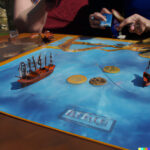Are you looking to dominate the 1941 Axis and Allies board game? Look no further. In this strategy guide, we will provide you with expert tips and tactics to help you secure victory as either the Axis or Allied powers. Whether you’re new to the game or a seasoned player, our comprehensive guide will equip you with the knowledge and strategies needed to outmaneuver your opponents.
The 1941 Axis and Allies board game is a classic war strategy game that simulates World War II. Players take on the roles of either the Axis Powers (Germany and Japan) or the Allied Powers (United States, United Kingdom, and Soviet Union) in a battle for global dominance. With historically accurate game pieces and a dynamic gameplay experience, mastering this game requires careful planning, strategic thinking, and keen decision-making skills.
In this introductory section, we will provide an overview of the game and its key components, including an introduction to both the Axis and Allied powers. We will also discuss how to set up the game board and pieces, setting the stage for an intense and immersive gaming experience.
Whether you’re playing as Germany, Japan, United States, United Kingdom, or Soviet Union – this guide will give you the edge you need to achieve victory in 1941 Axis and Allies board game.
Understanding the Axis Powers (Germany and Japan) in the Game
When playing the 1941 Axis and Allies Board Game, understanding the Axis Powers, specifically Germany and Japan, is crucial to achieving victory. Both Germany and Japan have unique strengths and weaknesses that players must take into account when formulating their strategies. Here are some key points to consider when taking control of these two powerful nations in the game:
- Germany: As Germany, it is important to focus on a swift and aggressive offensive strategy. Utilize your superior land forces and air power to quickly conquer European territories while maintaining a strong defensive position against potential Allied attacks.
- Japan: When playing as Japan, it is essential to exploit your naval strength and focus on expansion into the Asia-Pacific region. Utilize your powerful fleet to secure valuable islands, establish a strong air presence, and put pressure on the United States and United Kingdom.
In addition to understanding their individual strategies, it is important for players controlling the Axis Powers to coordinate their efforts effectively. Working together with your fellow Axis Power player(s) can greatly enhance your chances of success on the battlefield.
Players taking on the roles of Germany and Japan should also be prepared for potential setbacks throughout the game. It’s important to adapt and adjust your strategies accordingly based on how the game unfolds. For example, if you encounter staunch resistance from Allied forces in certain regions, consider shifting your focus to more vulnerable areas where you can make significant gains.
Overall, mastering the unique strengths and weaknesses of Germany and Japan in the 1941 Axis and Allies Board Game is essential for achieving victory as part of the Axis Powers alliance. By combining effective individual strategies with coordinated teamwork, players can greatly increase their chances of coming out on top in this epic battle for global domination.
Understanding the Allied Powers (United States, United Kingdom, and Soviet Union) in the Game
The Allied Powers in the 1941 Axis and Allies Board Game consist of the United States, United Kingdom, and Soviet Union. Each of these nations brings a unique set of strengths and strategies to the game, making them formidable opponents for the Axis Powers. Understanding the capabilities of each Allied Power is crucial for developing a winning strategy in the game.
Here are some key aspects to consider about each of the Allied Powers:
- The United States: The United States starts with a large industrial base and significant resources, making it a powerhouse in terms of production. As a result, the U.S. can quickly build up its forces and project power across both the Pacific and European theaters of war.
- The United Kingdom: The UK begins with territories spread across different regions, including Europe, Africa, and Asia. Its naval forces are critical for protecting supply lines, defending territories, and launching amphibious assaults. The UK’s ability to mobilize forces from multiple fronts makes it a versatile player in the game.
- Soviet Union: The Soviet Union starts with vast territory but faces an immediate threat from Germany. Its ability to withstand German aggression and eventually mount a counteroffensive is crucial for turning the tide of war in favor of the Allies. The USSR’s resilience in defending its borders is essential for preventing Axis expansion.
Understanding how to effectively utilize the industrial capabilities, geographical positioning, and military strengths of each Allied Power is vital for coordinating joint offensives against the Axis Powers while also defending against their aggression.
By leveraging these unique advantages and working together as a cohesive team, players controlling the Allied Powers can develop effective strategies to tip the balance of power in their favor.
Setting Up the Game Board and Pieces
The 1941 Axis and Allies board game is a classic strategy game that allows players to take on the roles of the Axis Powers (Germany and Japan) or the Allied Powers (United States, United Kingdom, and Soviet Union) during World War II. Before diving into gameplay strategies, it’s important to understand how to properly set up the game board and pieces.
To begin, unfold the game board and place it in the center of the table. Each player should choose whether they want to play as an Axis Power or an Allied Power, and they will then take control of all the pieces for their respective side. The players should then place their starting units on the designated territories as indicated in the game manual.
It’s crucial for players to understand the different types of pieces in the game, including infantry, tanks, airplanes, battleships, and industrial complexes. Each type of piece has its own unique abilities and limitations that players must consider when developing their strategies throughout the game. Once all pieces are in their correct positions on the board, players are ready to begin implementing their tactics as either Axis or Allied powers.
| Game Board Setup | Game Pieces Overview |
|---|---|
| Unfold game board and place in center of table | Understand different types of pieces: infantry, tanks, airplanes, battleships, industrial complexes |
| Each player chooses Axis or Allied side | Place starting units on designated territories |
Basic Strategies for the Axis Powers
The Axis Powers in the 1941 Axis and Allies Board Game, comprised of Germany and Japan, present a unique challenge for players due to their initial advantages in military strength and territory control. Understanding the basic strategies for the Axis Powers is crucial for any player looking to secure victory in the game.
Initial Objectives
The initial objective for the Axis Powers should be to quickly expand their territories while simultaneously weakening the Allied Powers. This can be achieved by focusing on rapid conquests and strategically deploying forces to gain control of key territories.
Maneuvering Forces
Both Germany and Japan can benefit from maneuvering their forces in a way that allows them to maintain strong defensive positions while also launching offensive attacks against the Allied Powers. It is important for players controlling the Axis Powers to understand when to engage in battle, when to retreat, and how to effectively use their military units on both land and sea.
Economic Warfare
Another essential aspect of basic strategy for the Axis Powers is employing economic warfare tactics. By disrupting trade routes, cutting off supply lines, and controlling resource-rich territories, Germany and Japan can weaken the economies of the Allied Powers, ultimately tipping the balance of power in their favor.
By mastering these basic strategies for the Axis Powers, players can set themselves up for success as they take on the challenge of leading Germany and Japan to victory in the 1941 Axis and Allies Board Game. Understanding these fundamental tactics will provide a solid foundation for more advanced gameplay tactics that are crucial for securing a win.
Basic Strategies for the Allied Powers
The 1941 Axis and Allies Board Game places players in the midst of World War II, with the Axis Powers (Germany and Japan) pitted against the Allied Powers (United States, United Kingdom, and Soviet Union). In order to achieve victory, it is crucial for players to understand the strengths and weaknesses of each side, as well as implement effective strategies.
This section will focus on basic strategies for the Allied Powers, providing insight into how to maximize their potential for success.
Economic Advantage
One key advantage that the Allied Powers have over the Axis Powers is their economic strength. The United States in particular starts with a substantial income which can be utilized to build up forces both in the Pacific and European theaters. The United Kingdom also has a strong economy and can benefit from its control of multiple territories spread across different regions. Leveraging this economic advantage early on can allow for a more robust defense against the Axis Powers’ onslaught.
Unity and Cooperation
Another important strategy for the Allied Powers is to work together in a coordinated manner. Given their diverse geographical locations on the game board, it’s essential for players controlling these nations to communicate and plan jointly in order to combat the Axis Powers effectively. Whether it’s coordinating naval operations, providing air support, or sharing resources, teamwork among the Allies can tip the scales in their favor.
Utilize Strategic Positions
The Allied Powers possess strategic positions such as sea routes, islands, and coastal areas that can be used to their advantage. Utilizing these positions effectively can help safeguard vital supply lines and staging areas for offensives against enemy forces. By understanding how to make best use of these geographical features, players controlling the Allied Powers can hinder enemy movements while simultaneously strengthening their own positions on the game board.
Advanced Gameplay Tactics for Both Sides
In the 1941 Axis and Allies board game, players must employ advanced tactics to outmaneuver their opponents and achieve victory. For both the Axis Powers (Germany and Japan) and the Allied Powers (United States, United Kingdom, and Soviet Union), understanding how to effectively use units, resources, and territory control is essential.
One of the key advanced tactics for both sides is maximizing unit efficiency. This means using each unit to its full potential by strategically positioning them on the game board. For example, tanks should be used for breakthroughs in enemy lines, while infantry units can hold territories and defend key positions. Understanding the strengths and weaknesses of each unit is crucial in maximizing their impact on the game.
Another important advanced tactic is resource management. Players must carefully consider how to allocate their resources to achieve both short-term and long-term objectives. Whether it’s purchasing new units, investing in technology development, or maintaining a solid defense, managing resources effectively can make a significant difference in the outcome of the game.
Furthermore, employing diplomatic strategies can also be a game-changer in 1941 Axis and Allies. Forming alliances with other players or pursuing individual objectives that align with larger strategic goals can create opportunities for success. Being able to negotiate with other players and adapt to changing circumstances on the game board is an important aspect of advanced gameplay tactics.
| Advanced Gameplay Tactics | Importance |
|---|---|
| Maximizing Unit Efficiency | Crucial for gaining strategic advantage |
| Resource Management | Determines short-term and long-term success |
| Diplomatic Strategies | Creates opportunities for success |
Tips for Victory and Achieving Game Objectives
When playing the 1941 Axis and Allies Board Game, achieving victory and successfully completing game objectives requires strategic planning, tactical decision-making, and adept use of resources. Both the Axis Powers (Germany and Japan) and the Allied Powers (United States, United Kingdom, and Soviet Union) have distinct strengths and weaknesses that players must consider when formulating their gameplay strategies.
One key tip for achieving victory in the game is to prioritize controlling key territories and strategically placing your forces. For the Axis Powers, this may involve focusing on capturing important economic centers such as Moscow or Cairo, while the Allied Powers may seek to maintain control of crucial areas like Western Europe or the Pacific islands. By securing these territories, players can gain essential income for purchasing additional units and strengthen their position on the game board.
Another crucial aspect of achieving game objectives in 1941 Axis and Allies is effective communication and coordination among allied nations. Players must work together to devise a cohesive strategy that leverages each country’s unique capabilities.
For instance, the United States can provide logistical support and reinforcements to bolster British forces in Europe, while the Soviet Union may focus on repelling German advances in Eastern Europe. Building a united front against the opposing powers is essential for realizing victory in this strategic board game.
In addition to territorial control and alliance cooperation, successful players must also adapt their strategies based on evolving game conditions. Flexibility is key in navigating unexpected developments or setbacks during gameplay. Whether it involves adjusting defense priorities, leveraging surprise attacks, or reevaluating resource allocation, being able to pivot your strategy according to changing circumstances can be pivotal in achieving victory in the 1941 Axis and Allies Board Game.
Conclusion and Final Thoughts on Mastering the 1941 Axis and Allies Board Game Strategy Guide
In conclusion, mastering the 1941 Axis and Allies Board Game Strategy Guide requires a balance of understanding the strengths and weaknesses of both the Axis Powers and the Allied Powers, as well as implementing effective gameplay tactics. By familiarizing oneself with the setup of the game board and pieces, as well as basic and advanced strategies for both sides, players can improve their chances of achieving victory and meeting game objectives.
For the Axis Powers (Germany and Japan), it is crucial to focus on early aggression while also ensuring a solid defense to protect against potential Allied offensives. Understanding how to effectively utilize naval and air power, as well as coordinating attacks between Germany and Japan, is key to applying successful strategies in gameplay.
Conversely, the Allied Powers (United States, United Kingdom, and Soviet Union) must work together to withstand the initial onslaught from the Axis Powers while gradually building up their forces to launch counteroffensives. Cooperation between the Allies is essential in order to effectively control territories, provide support to each other’s forces, and ultimately turn the tide of war in their favor.
Mastering this strategy guide not only allows players to enjoy a deeper level of gameplay but also fosters an appreciation for historical military tactics. As with any strategy game, practice makes perfect; by applying these strategies and learning from experience, players can hone their skills and become formidable opponents in the 1941 Axis and Allies Board Game.
Frequently Asked Questions
How Long Does Axis and Allies 1941 Take?
Axis and Allies 1941 typically takes around 2-3 hours to play, depending on the experience of the players. While some games may be shorter, others can stretch to 4 hours if there are beginners involved.
Do They Still Make Axis and Allies Board Game?
Yes, Axis and Allies is still being made as a board game. The game has gone through various editions and updates over the years, with new versions being released as recently as 2020.
How Does Attacking Work in Axis and Allies?
Attacking in Axis and Allies involves rolling dice to determine the outcome of battles. The number of units involved in the attack, along with any supporting units or special abilities, factor into the dice rolls to determine casualties and overall success in combat.

I love playing all kinds of games – from classics like Monopoly to modern favourites like Ticket to Ride.
I created this blog as a way to share my love of board games with others, and provide information on the latest releases and news in the industry.





